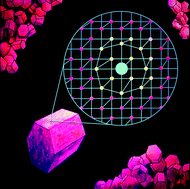The effect of Eu3+ and Gd3+ co-doping on the morphology and luminescence of NaYF4:Eu3+, Gd3+ phosphors†
Abstract
β-NaYF4:Eu3+ microparticles co-doped with Gd3+ ions were obtained by hydrothermal synthesis at 180 °C using citric acid as a stabilizing agent. All synthesized materials have a β-NaYF4 crystalline phase, where the unit cell volume increases upon the addition of Eu3+ and Gd3+ ions. The particles have a hexagonal prism shape and a size of 40–714 nm, where Eu3+ and Gd3+ doping results in size reduction. Upon 393 nm excitation, phosphors exhibit distinct emission peaks centered at 591, 615, and 695 nm and a weak band at 650 nm attributed to 5D0–7FJ transitions (J = 1–4). The optimum Eu3+ doping concentration was found to be 30% in the NaYF4 host. Concentration quenching was realized through dipole–dipole interactions. Kinetic measurements showed a gradual decline of the 5D0 lifetime from 6.7 ms to 2.2 ms along with an increase in Eu3+ doping concentration. Co-doping of the small Gd3+ number led to an increase of emission intensity and 5D0 lifetime. The effects of Eu3+ doping and Gd3+ co-doping on radiative and nonradiative decay rates were studied using 4f–4f intensity theory.



 Please wait while we load your content...
Please wait while we load your content...